Pain Assessment: Strategy, Patient Care, and Outcomes Analysis
VerifiedAdded on 2021/05/31
|13
|3306
|32
Report
AI Summary
This report provides a detailed analysis of pain assessment strategies, emphasizing the importance of acknowledging patient pain, establishing therapeutic interactions, and utilizing clinical reasoning. It outlines the steps involved in assessing pain, including the use of various assessment tools and obtaining necessary equipment. The report covers the history of pain onset, location, duration, characteristics, aggravating and relieving factors, and treatment options. It also highlights the importance of cleaning, replacing, and disposing of used equipment, as well as documenting patient experiences and outcomes. Finally, the report stresses the significance of reflecting on the approach to a patient's pain experience to improve nursing practice and patient care.

Running head: PAIN ASSESSMENT
Pain Assessment
Name of the Student:
Name of the University:
Author Note:
Pain Assessment
Name of the Student:
Name of the University:
Author Note:
Paraphrase This Document
Need a fresh take? Get an instant paraphrase of this document with our AI Paraphraser

1PAIN ASSESSMENT
Table of Contents
Introduction......................................................................................................................................2
Pain assessment strategy..................................................................................................................2
References........................................................................................................................................9
Table of Contents
Introduction......................................................................................................................................2
Pain assessment strategy..................................................................................................................2
References........................................................................................................................................9
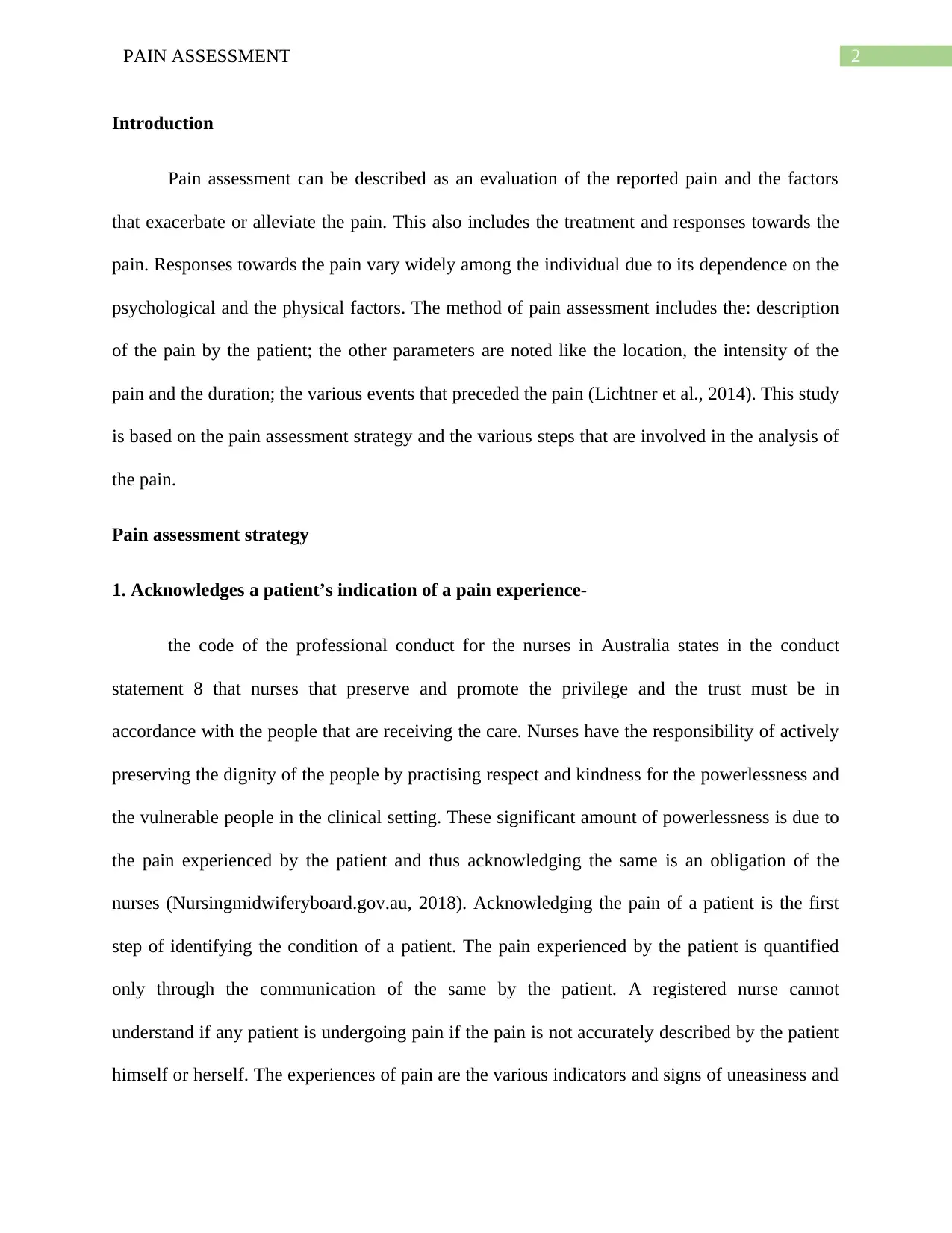
2PAIN ASSESSMENT
Introduction
Pain assessment can be described as an evaluation of the reported pain and the factors
that exacerbate or alleviate the pain. This also includes the treatment and responses towards the
pain. Responses towards the pain vary widely among the individual due to its dependence on the
psychological and the physical factors. The method of pain assessment includes the: description
of the pain by the patient; the other parameters are noted like the location, the intensity of the
pain and the duration; the various events that preceded the pain (Lichtner et al., 2014). This study
is based on the pain assessment strategy and the various steps that are involved in the analysis of
the pain.
Pain assessment strategy
1. Acknowledges a patient’s indication of a pain experience-
the code of the professional conduct for the nurses in Australia states in the conduct
statement 8 that nurses that preserve and promote the privilege and the trust must be in
accordance with the people that are receiving the care. Nurses have the responsibility of actively
preserving the dignity of the people by practising respect and kindness for the powerlessness and
the vulnerable people in the clinical setting. These significant amount of powerlessness is due to
the pain experienced by the patient and thus acknowledging the same is an obligation of the
nurses (Nursingmidwiferyboard.gov.au, 2018). Acknowledging the pain of a patient is the first
step of identifying the condition of a patient. The pain experienced by the patient is quantified
only through the communication of the same by the patient. A registered nurse cannot
understand if any patient is undergoing pain if the pain is not accurately described by the patient
himself or herself. The experiences of pain are the various indicators and signs of uneasiness and
Introduction
Pain assessment can be described as an evaluation of the reported pain and the factors
that exacerbate or alleviate the pain. This also includes the treatment and responses towards the
pain. Responses towards the pain vary widely among the individual due to its dependence on the
psychological and the physical factors. The method of pain assessment includes the: description
of the pain by the patient; the other parameters are noted like the location, the intensity of the
pain and the duration; the various events that preceded the pain (Lichtner et al., 2014). This study
is based on the pain assessment strategy and the various steps that are involved in the analysis of
the pain.
Pain assessment strategy
1. Acknowledges a patient’s indication of a pain experience-
the code of the professional conduct for the nurses in Australia states in the conduct
statement 8 that nurses that preserve and promote the privilege and the trust must be in
accordance with the people that are receiving the care. Nurses have the responsibility of actively
preserving the dignity of the people by practising respect and kindness for the powerlessness and
the vulnerable people in the clinical setting. These significant amount of powerlessness is due to
the pain experienced by the patient and thus acknowledging the same is an obligation of the
nurses (Nursingmidwiferyboard.gov.au, 2018). Acknowledging the pain of a patient is the first
step of identifying the condition of a patient. The pain experienced by the patient is quantified
only through the communication of the same by the patient. A registered nurse cannot
understand if any patient is undergoing pain if the pain is not accurately described by the patient
himself or herself. The experiences of pain are the various indicators and signs of uneasiness and
⊘ This is a preview!⊘
Do you want full access?
Subscribe today to unlock all pages.

Trusted by 1+ million students worldwide
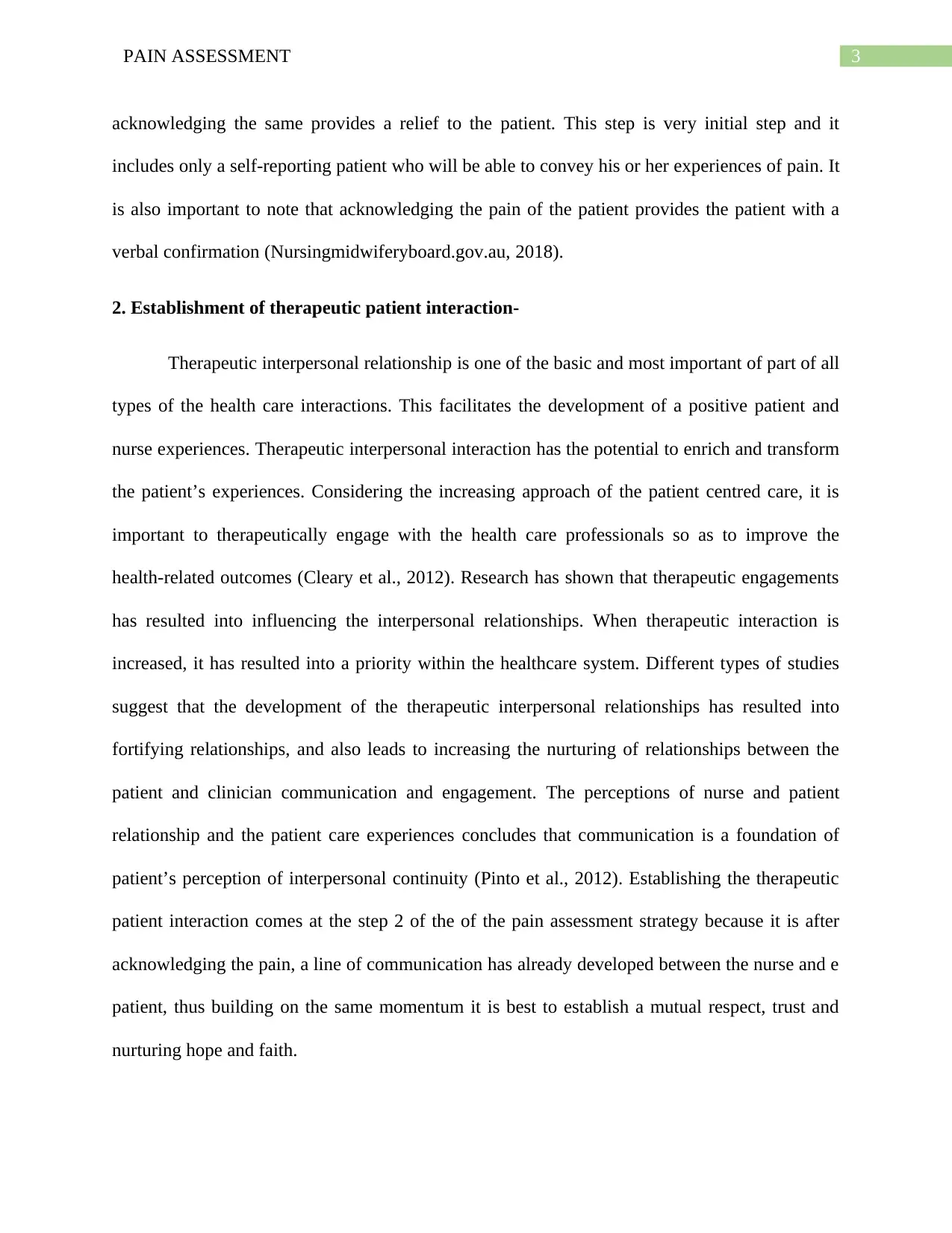
3PAIN ASSESSMENT
acknowledging the same provides a relief to the patient. This step is very initial step and it
includes only a self-reporting patient who will be able to convey his or her experiences of pain. It
is also important to note that acknowledging the pain of the patient provides the patient with a
verbal confirmation (Nursingmidwiferyboard.gov.au, 2018).
2. Establishment of therapeutic patient interaction-
Therapeutic interpersonal relationship is one of the basic and most important of part of all
types of the health care interactions. This facilitates the development of a positive patient and
nurse experiences. Therapeutic interpersonal interaction has the potential to enrich and transform
the patient’s experiences. Considering the increasing approach of the patient centred care, it is
important to therapeutically engage with the health care professionals so as to improve the
health-related outcomes (Cleary et al., 2012). Research has shown that therapeutic engagements
has resulted into influencing the interpersonal relationships. When therapeutic interaction is
increased, it has resulted into a priority within the healthcare system. Different types of studies
suggest that the development of the therapeutic interpersonal relationships has resulted into
fortifying relationships, and also leads to increasing the nurturing of relationships between the
patient and clinician communication and engagement. The perceptions of nurse and patient
relationship and the patient care experiences concludes that communication is a foundation of
patient’s perception of interpersonal continuity (Pinto et al., 2012). Establishing the therapeutic
patient interaction comes at the step 2 of the of the pain assessment strategy because it is after
acknowledging the pain, a line of communication has already developed between the nurse and e
patient, thus building on the same momentum it is best to establish a mutual respect, trust and
nurturing hope and faith.
acknowledging the same provides a relief to the patient. This step is very initial step and it
includes only a self-reporting patient who will be able to convey his or her experiences of pain. It
is also important to note that acknowledging the pain of the patient provides the patient with a
verbal confirmation (Nursingmidwiferyboard.gov.au, 2018).
2. Establishment of therapeutic patient interaction-
Therapeutic interpersonal relationship is one of the basic and most important of part of all
types of the health care interactions. This facilitates the development of a positive patient and
nurse experiences. Therapeutic interpersonal interaction has the potential to enrich and transform
the patient’s experiences. Considering the increasing approach of the patient centred care, it is
important to therapeutically engage with the health care professionals so as to improve the
health-related outcomes (Cleary et al., 2012). Research has shown that therapeutic engagements
has resulted into influencing the interpersonal relationships. When therapeutic interaction is
increased, it has resulted into a priority within the healthcare system. Different types of studies
suggest that the development of the therapeutic interpersonal relationships has resulted into
fortifying relationships, and also leads to increasing the nurturing of relationships between the
patient and clinician communication and engagement. The perceptions of nurse and patient
relationship and the patient care experiences concludes that communication is a foundation of
patient’s perception of interpersonal continuity (Pinto et al., 2012). Establishing the therapeutic
patient interaction comes at the step 2 of the of the pain assessment strategy because it is after
acknowledging the pain, a line of communication has already developed between the nurse and e
patient, thus building on the same momentum it is best to establish a mutual respect, trust and
nurturing hope and faith.
Paraphrase This Document
Need a fresh take? Get an instant paraphrase of this document with our AI Paraphraser
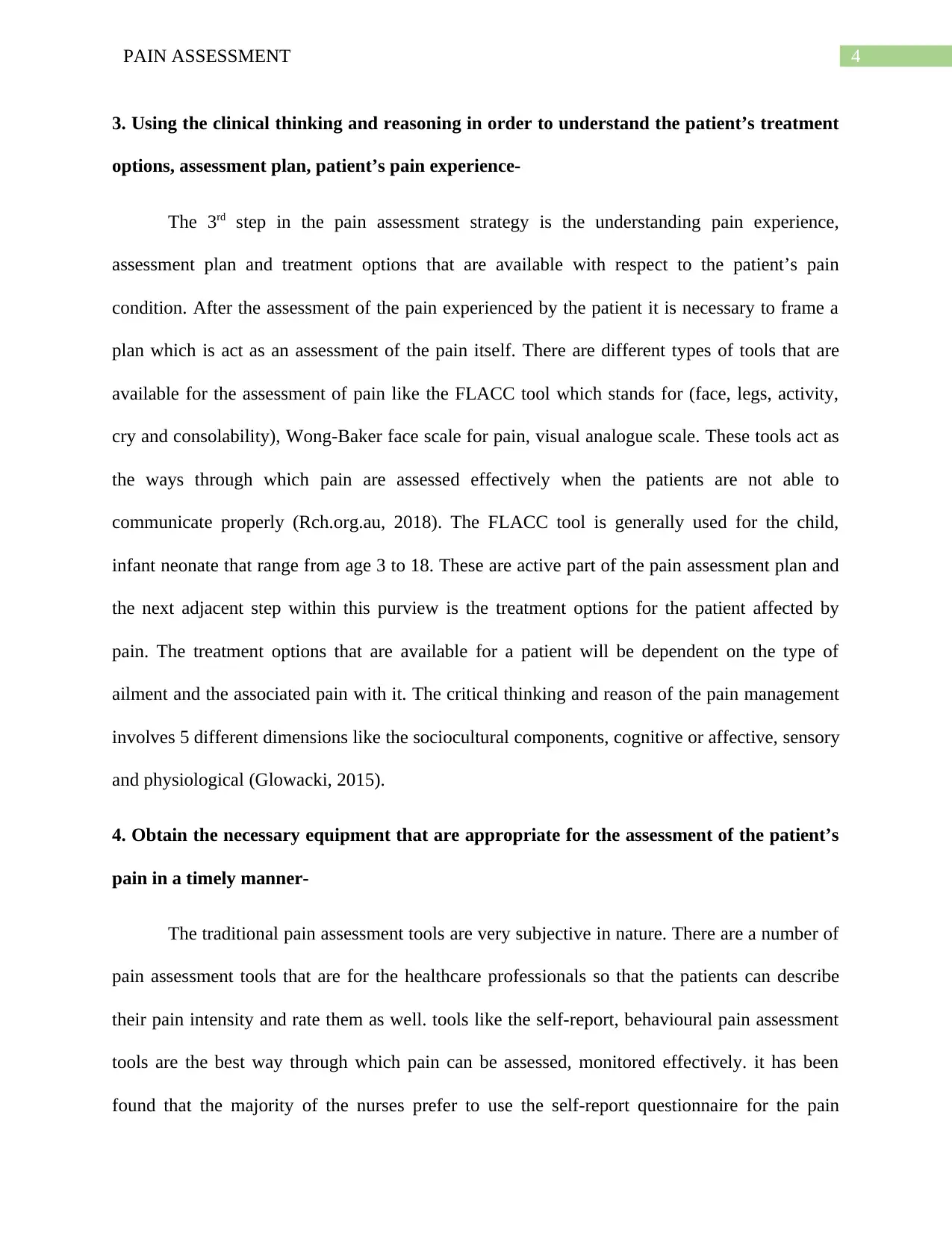
4PAIN ASSESSMENT
3. Using the clinical thinking and reasoning in order to understand the patient’s treatment
options, assessment plan, patient’s pain experience-
The 3rd step in the pain assessment strategy is the understanding pain experience,
assessment plan and treatment options that are available with respect to the patient’s pain
condition. After the assessment of the pain experienced by the patient it is necessary to frame a
plan which is act as an assessment of the pain itself. There are different types of tools that are
available for the assessment of pain like the FLACC tool which stands for (face, legs, activity,
cry and consolability), Wong-Baker face scale for pain, visual analogue scale. These tools act as
the ways through which pain are assessed effectively when the patients are not able to
communicate properly (Rch.org.au, 2018). The FLACC tool is generally used for the child,
infant neonate that range from age 3 to 18. These are active part of the pain assessment plan and
the next adjacent step within this purview is the treatment options for the patient affected by
pain. The treatment options that are available for a patient will be dependent on the type of
ailment and the associated pain with it. The critical thinking and reason of the pain management
involves 5 different dimensions like the sociocultural components, cognitive or affective, sensory
and physiological (Glowacki, 2015).
4. Obtain the necessary equipment that are appropriate for the assessment of the patient’s
pain in a timely manner-
The traditional pain assessment tools are very subjective in nature. There are a number of
pain assessment tools that are for the healthcare professionals so that the patients can describe
their pain intensity and rate them as well. tools like the self-report, behavioural pain assessment
tools are the best way through which pain can be assessed, monitored effectively. it has been
found that the majority of the nurses prefer to use the self-report questionnaire for the pain
3. Using the clinical thinking and reasoning in order to understand the patient’s treatment
options, assessment plan, patient’s pain experience-
The 3rd step in the pain assessment strategy is the understanding pain experience,
assessment plan and treatment options that are available with respect to the patient’s pain
condition. After the assessment of the pain experienced by the patient it is necessary to frame a
plan which is act as an assessment of the pain itself. There are different types of tools that are
available for the assessment of pain like the FLACC tool which stands for (face, legs, activity,
cry and consolability), Wong-Baker face scale for pain, visual analogue scale. These tools act as
the ways through which pain are assessed effectively when the patients are not able to
communicate properly (Rch.org.au, 2018). The FLACC tool is generally used for the child,
infant neonate that range from age 3 to 18. These are active part of the pain assessment plan and
the next adjacent step within this purview is the treatment options for the patient affected by
pain. The treatment options that are available for a patient will be dependent on the type of
ailment and the associated pain with it. The critical thinking and reason of the pain management
involves 5 different dimensions like the sociocultural components, cognitive or affective, sensory
and physiological (Glowacki, 2015).
4. Obtain the necessary equipment that are appropriate for the assessment of the patient’s
pain in a timely manner-
The traditional pain assessment tools are very subjective in nature. There are a number of
pain assessment tools that are for the healthcare professionals so that the patients can describe
their pain intensity and rate them as well. tools like the self-report, behavioural pain assessment
tools are the best way through which pain can be assessed, monitored effectively. it has been
found that the majority of the nurses prefer to use the self-report questionnaire for the pain
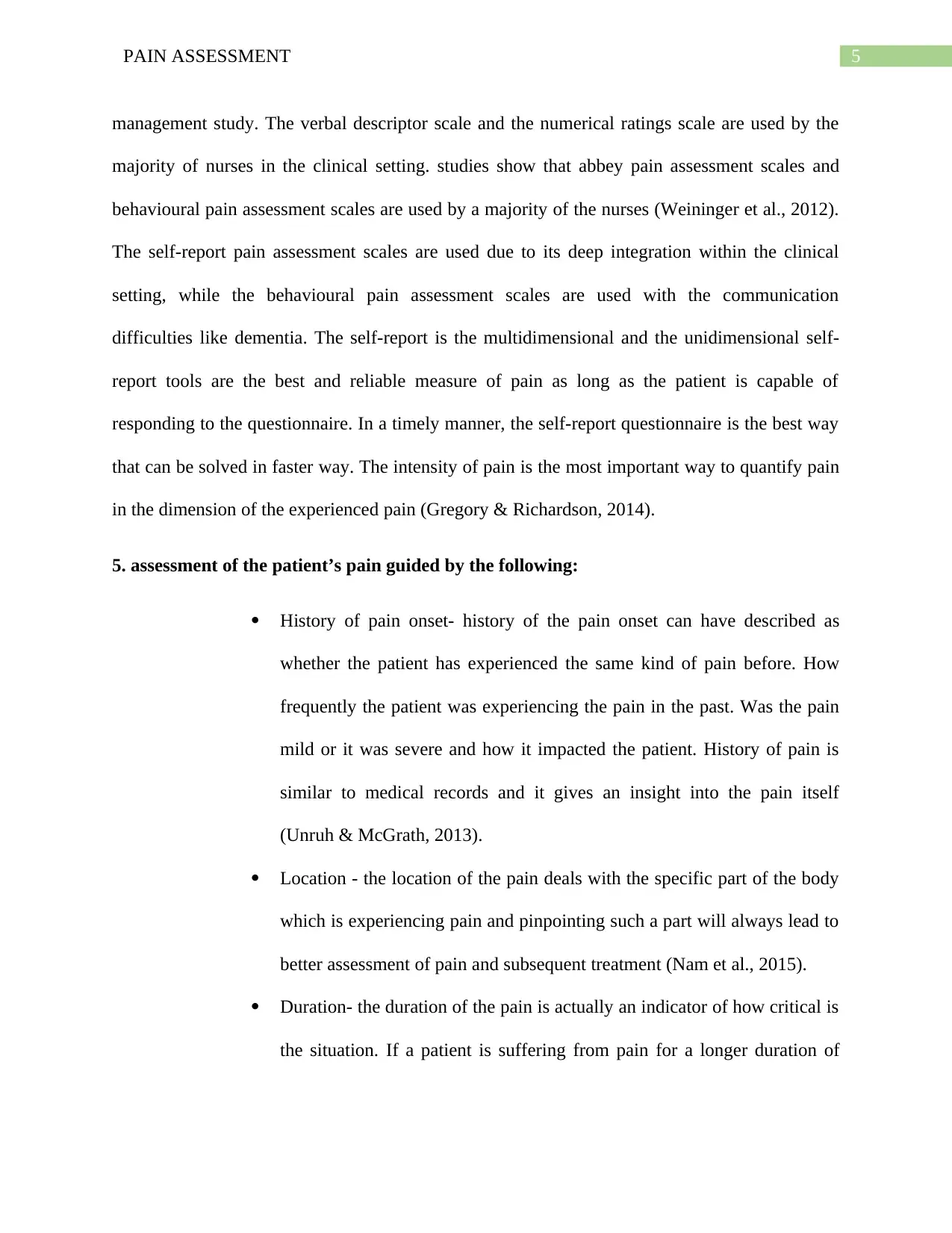
5PAIN ASSESSMENT
management study. The verbal descriptor scale and the numerical ratings scale are used by the
majority of nurses in the clinical setting. studies show that abbey pain assessment scales and
behavioural pain assessment scales are used by a majority of the nurses (Weininger et al., 2012).
The self-report pain assessment scales are used due to its deep integration within the clinical
setting, while the behavioural pain assessment scales are used with the communication
difficulties like dementia. The self-report is the multidimensional and the unidimensional self-
report tools are the best and reliable measure of pain as long as the patient is capable of
responding to the questionnaire. In a timely manner, the self-report questionnaire is the best way
that can be solved in faster way. The intensity of pain is the most important way to quantify pain
in the dimension of the experienced pain (Gregory & Richardson, 2014).
5. assessment of the patient’s pain guided by the following:
History of pain onset- history of the pain onset can have described as
whether the patient has experienced the same kind of pain before. How
frequently the patient was experiencing the pain in the past. Was the pain
mild or it was severe and how it impacted the patient. History of pain is
similar to medical records and it gives an insight into the pain itself
(Unruh & McGrath, 2013).
Location - the location of the pain deals with the specific part of the body
which is experiencing pain and pinpointing such a part will always lead to
better assessment of pain and subsequent treatment (Nam et al., 2015).
Duration- the duration of the pain is actually an indicator of how critical is
the situation. If a patient is suffering from pain for a longer duration of
management study. The verbal descriptor scale and the numerical ratings scale are used by the
majority of nurses in the clinical setting. studies show that abbey pain assessment scales and
behavioural pain assessment scales are used by a majority of the nurses (Weininger et al., 2012).
The self-report pain assessment scales are used due to its deep integration within the clinical
setting, while the behavioural pain assessment scales are used with the communication
difficulties like dementia. The self-report is the multidimensional and the unidimensional self-
report tools are the best and reliable measure of pain as long as the patient is capable of
responding to the questionnaire. In a timely manner, the self-report questionnaire is the best way
that can be solved in faster way. The intensity of pain is the most important way to quantify pain
in the dimension of the experienced pain (Gregory & Richardson, 2014).
5. assessment of the patient’s pain guided by the following:
History of pain onset- history of the pain onset can have described as
whether the patient has experienced the same kind of pain before. How
frequently the patient was experiencing the pain in the past. Was the pain
mild or it was severe and how it impacted the patient. History of pain is
similar to medical records and it gives an insight into the pain itself
(Unruh & McGrath, 2013).
Location - the location of the pain deals with the specific part of the body
which is experiencing pain and pinpointing such a part will always lead to
better assessment of pain and subsequent treatment (Nam et al., 2015).
Duration- the duration of the pain is actually an indicator of how critical is
the situation. If a patient is suffering from pain for a longer duration of
⊘ This is a preview!⊘
Do you want full access?
Subscribe today to unlock all pages.

Trusted by 1+ million students worldwide
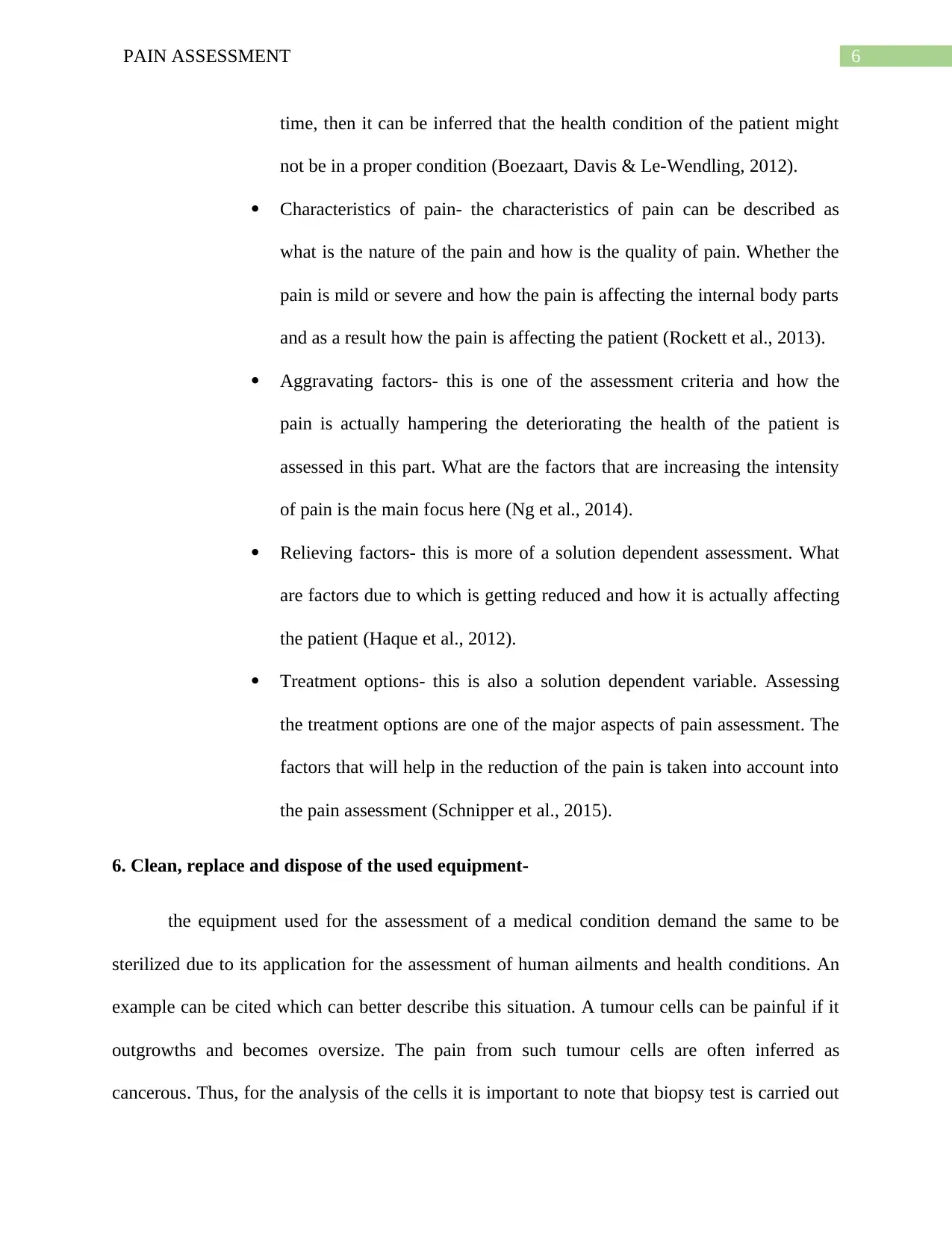
6PAIN ASSESSMENT
time, then it can be inferred that the health condition of the patient might
not be in a proper condition (Boezaart, Davis & Le-Wendling, 2012).
Characteristics of pain- the characteristics of pain can be described as
what is the nature of the pain and how is the quality of pain. Whether the
pain is mild or severe and how the pain is affecting the internal body parts
and as a result how the pain is affecting the patient (Rockett et al., 2013).
Aggravating factors- this is one of the assessment criteria and how the
pain is actually hampering the deteriorating the health of the patient is
assessed in this part. What are the factors that are increasing the intensity
of pain is the main focus here (Ng et al., 2014).
Relieving factors- this is more of a solution dependent assessment. What
are factors due to which is getting reduced and how it is actually affecting
the patient (Haque et al., 2012).
Treatment options- this is also a solution dependent variable. Assessing
the treatment options are one of the major aspects of pain assessment. The
factors that will help in the reduction of the pain is taken into account into
the pain assessment (Schnipper et al., 2015).
6. Clean, replace and dispose of the used equipment-
the equipment used for the assessment of a medical condition demand the same to be
sterilized due to its application for the assessment of human ailments and health conditions. An
example can be cited which can better describe this situation. A tumour cells can be painful if it
outgrowths and becomes oversize. The pain from such tumour cells are often inferred as
cancerous. Thus, for the analysis of the cells it is important to note that biopsy test is carried out
time, then it can be inferred that the health condition of the patient might
not be in a proper condition (Boezaart, Davis & Le-Wendling, 2012).
Characteristics of pain- the characteristics of pain can be described as
what is the nature of the pain and how is the quality of pain. Whether the
pain is mild or severe and how the pain is affecting the internal body parts
and as a result how the pain is affecting the patient (Rockett et al., 2013).
Aggravating factors- this is one of the assessment criteria and how the
pain is actually hampering the deteriorating the health of the patient is
assessed in this part. What are the factors that are increasing the intensity
of pain is the main focus here (Ng et al., 2014).
Relieving factors- this is more of a solution dependent assessment. What
are factors due to which is getting reduced and how it is actually affecting
the patient (Haque et al., 2012).
Treatment options- this is also a solution dependent variable. Assessing
the treatment options are one of the major aspects of pain assessment. The
factors that will help in the reduction of the pain is taken into account into
the pain assessment (Schnipper et al., 2015).
6. Clean, replace and dispose of the used equipment-
the equipment used for the assessment of a medical condition demand the same to be
sterilized due to its application for the assessment of human ailments and health conditions. An
example can be cited which can better describe this situation. A tumour cells can be painful if it
outgrowths and becomes oversize. The pain from such tumour cells are often inferred as
cancerous. Thus, for the analysis of the cells it is important to note that biopsy test is carried out
Paraphrase This Document
Need a fresh take? Get an instant paraphrase of this document with our AI Paraphraser
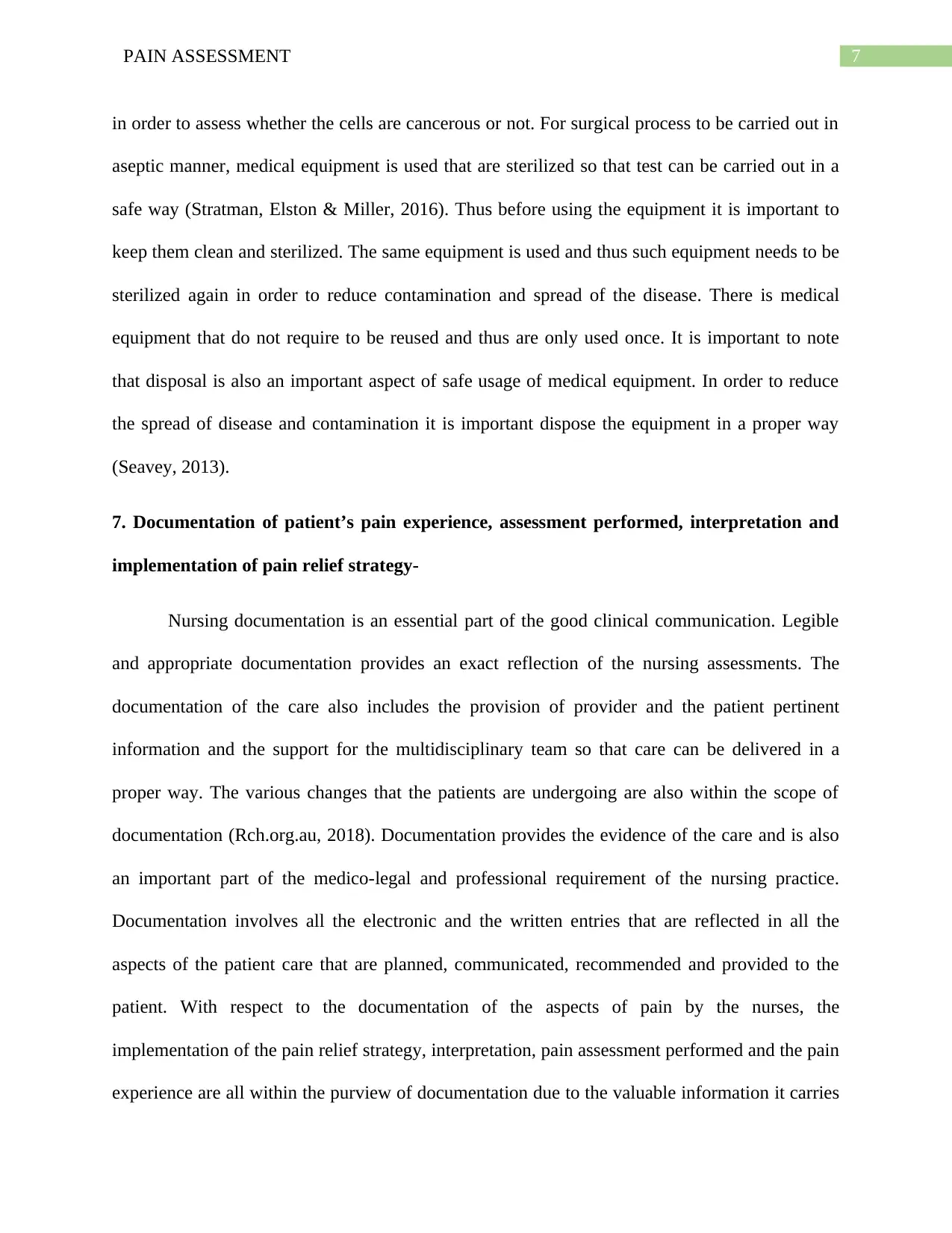
7PAIN ASSESSMENT
in order to assess whether the cells are cancerous or not. For surgical process to be carried out in
aseptic manner, medical equipment is used that are sterilized so that test can be carried out in a
safe way (Stratman, Elston & Miller, 2016). Thus before using the equipment it is important to
keep them clean and sterilized. The same equipment is used and thus such equipment needs to be
sterilized again in order to reduce contamination and spread of the disease. There is medical
equipment that do not require to be reused and thus are only used once. It is important to note
that disposal is also an important aspect of safe usage of medical equipment. In order to reduce
the spread of disease and contamination it is important dispose the equipment in a proper way
(Seavey, 2013).
7. Documentation of patient’s pain experience, assessment performed, interpretation and
implementation of pain relief strategy-
Nursing documentation is an essential part of the good clinical communication. Legible
and appropriate documentation provides an exact reflection of the nursing assessments. The
documentation of the care also includes the provision of provider and the patient pertinent
information and the support for the multidisciplinary team so that care can be delivered in a
proper way. The various changes that the patients are undergoing are also within the scope of
documentation (Rch.org.au, 2018). Documentation provides the evidence of the care and is also
an important part of the medico-legal and professional requirement of the nursing practice.
Documentation involves all the electronic and the written entries that are reflected in all the
aspects of the patient care that are planned, communicated, recommended and provided to the
patient. With respect to the documentation of the aspects of pain by the nurses, the
implementation of the pain relief strategy, interpretation, pain assessment performed and the pain
experience are all within the purview of documentation due to the valuable information it carries
in order to assess whether the cells are cancerous or not. For surgical process to be carried out in
aseptic manner, medical equipment is used that are sterilized so that test can be carried out in a
safe way (Stratman, Elston & Miller, 2016). Thus before using the equipment it is important to
keep them clean and sterilized. The same equipment is used and thus such equipment needs to be
sterilized again in order to reduce contamination and spread of the disease. There is medical
equipment that do not require to be reused and thus are only used once. It is important to note
that disposal is also an important aspect of safe usage of medical equipment. In order to reduce
the spread of disease and contamination it is important dispose the equipment in a proper way
(Seavey, 2013).
7. Documentation of patient’s pain experience, assessment performed, interpretation and
implementation of pain relief strategy-
Nursing documentation is an essential part of the good clinical communication. Legible
and appropriate documentation provides an exact reflection of the nursing assessments. The
documentation of the care also includes the provision of provider and the patient pertinent
information and the support for the multidisciplinary team so that care can be delivered in a
proper way. The various changes that the patients are undergoing are also within the scope of
documentation (Rch.org.au, 2018). Documentation provides the evidence of the care and is also
an important part of the medico-legal and professional requirement of the nursing practice.
Documentation involves all the electronic and the written entries that are reflected in all the
aspects of the patient care that are planned, communicated, recommended and provided to the
patient. With respect to the documentation of the aspects of pain by the nurses, the
implementation of the pain relief strategy, interpretation, pain assessment performed and the pain
experience are all within the purview of documentation due to the valuable information it carries
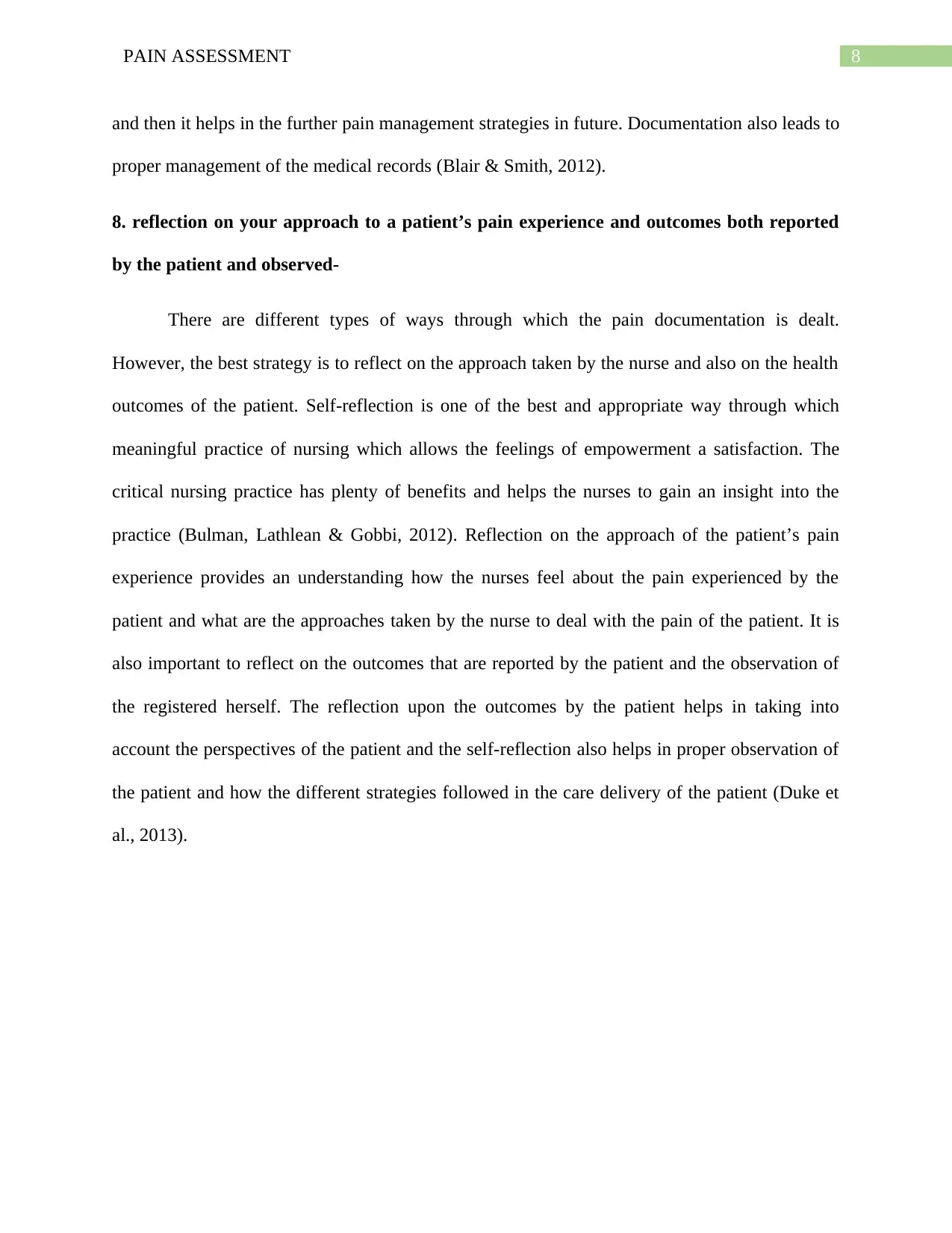
8PAIN ASSESSMENT
and then it helps in the further pain management strategies in future. Documentation also leads to
proper management of the medical records (Blair & Smith, 2012).
8. reflection on your approach to a patient’s pain experience and outcomes both reported
by the patient and observed-
There are different types of ways through which the pain documentation is dealt.
However, the best strategy is to reflect on the approach taken by the nurse and also on the health
outcomes of the patient. Self-reflection is one of the best and appropriate way through which
meaningful practice of nursing which allows the feelings of empowerment a satisfaction. The
critical nursing practice has plenty of benefits and helps the nurses to gain an insight into the
practice (Bulman, Lathlean & Gobbi, 2012). Reflection on the approach of the patient’s pain
experience provides an understanding how the nurses feel about the pain experienced by the
patient and what are the approaches taken by the nurse to deal with the pain of the patient. It is
also important to reflect on the outcomes that are reported by the patient and the observation of
the registered herself. The reflection upon the outcomes by the patient helps in taking into
account the perspectives of the patient and the self-reflection also helps in proper observation of
the patient and how the different strategies followed in the care delivery of the patient (Duke et
al., 2013).
and then it helps in the further pain management strategies in future. Documentation also leads to
proper management of the medical records (Blair & Smith, 2012).
8. reflection on your approach to a patient’s pain experience and outcomes both reported
by the patient and observed-
There are different types of ways through which the pain documentation is dealt.
However, the best strategy is to reflect on the approach taken by the nurse and also on the health
outcomes of the patient. Self-reflection is one of the best and appropriate way through which
meaningful practice of nursing which allows the feelings of empowerment a satisfaction. The
critical nursing practice has plenty of benefits and helps the nurses to gain an insight into the
practice (Bulman, Lathlean & Gobbi, 2012). Reflection on the approach of the patient’s pain
experience provides an understanding how the nurses feel about the pain experienced by the
patient and what are the approaches taken by the nurse to deal with the pain of the patient. It is
also important to reflect on the outcomes that are reported by the patient and the observation of
the registered herself. The reflection upon the outcomes by the patient helps in taking into
account the perspectives of the patient and the self-reflection also helps in proper observation of
the patient and how the different strategies followed in the care delivery of the patient (Duke et
al., 2013).
⊘ This is a preview!⊘
Do you want full access?
Subscribe today to unlock all pages.

Trusted by 1+ million students worldwide
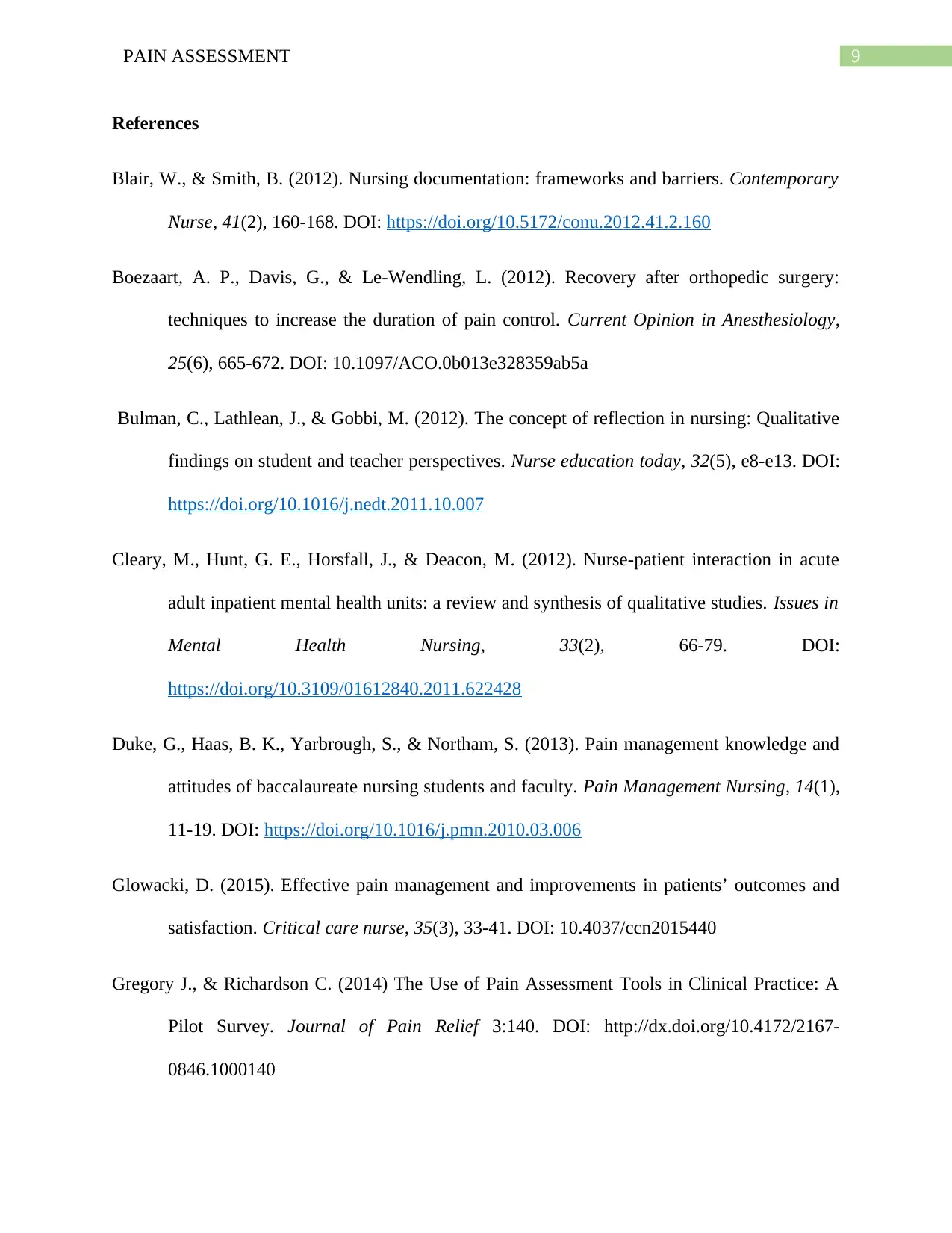
9PAIN ASSESSMENT
References
Blair, W., & Smith, B. (2012). Nursing documentation: frameworks and barriers. Contemporary
Nurse, 41(2), 160-168. DOI: https://doi.org/10.5172/conu.2012.41.2.160
Boezaart, A. P., Davis, G., & Le-Wendling, L. (2012). Recovery after orthopedic surgery:
techniques to increase the duration of pain control. Current Opinion in Anesthesiology,
25(6), 665-672. DOI: 10.1097/ACO.0b013e328359ab5a
Bulman, C., Lathlean, J., & Gobbi, M. (2012). The concept of reflection in nursing: Qualitative
findings on student and teacher perspectives. Nurse education today, 32(5), e8-e13. DOI:
https://doi.org/10.1016/j.nedt.2011.10.007
Cleary, M., Hunt, G. E., Horsfall, J., & Deacon, M. (2012). Nurse-patient interaction in acute
adult inpatient mental health units: a review and synthesis of qualitative studies. Issues in
Mental Health Nursing, 33(2), 66-79. DOI:
https://doi.org/10.3109/01612840.2011.622428
Duke, G., Haas, B. K., Yarbrough, S., & Northam, S. (2013). Pain management knowledge and
attitudes of baccalaureate nursing students and faculty. Pain Management Nursing, 14(1),
11-19. DOI: https://doi.org/10.1016/j.pmn.2010.03.006
Glowacki, D. (2015). Effective pain management and improvements in patients’ outcomes and
satisfaction. Critical care nurse, 35(3), 33-41. DOI: 10.4037/ccn2015440
Gregory J., & Richardson C. (2014) The Use of Pain Assessment Tools in Clinical Practice: A
Pilot Survey. Journal of Pain Relief 3:140. DOI: http://dx.doi.org/10.4172/2167-
0846.1000140
References
Blair, W., & Smith, B. (2012). Nursing documentation: frameworks and barriers. Contemporary
Nurse, 41(2), 160-168. DOI: https://doi.org/10.5172/conu.2012.41.2.160
Boezaart, A. P., Davis, G., & Le-Wendling, L. (2012). Recovery after orthopedic surgery:
techniques to increase the duration of pain control. Current Opinion in Anesthesiology,
25(6), 665-672. DOI: 10.1097/ACO.0b013e328359ab5a
Bulman, C., Lathlean, J., & Gobbi, M. (2012). The concept of reflection in nursing: Qualitative
findings on student and teacher perspectives. Nurse education today, 32(5), e8-e13. DOI:
https://doi.org/10.1016/j.nedt.2011.10.007
Cleary, M., Hunt, G. E., Horsfall, J., & Deacon, M. (2012). Nurse-patient interaction in acute
adult inpatient mental health units: a review and synthesis of qualitative studies. Issues in
Mental Health Nursing, 33(2), 66-79. DOI:
https://doi.org/10.3109/01612840.2011.622428
Duke, G., Haas, B. K., Yarbrough, S., & Northam, S. (2013). Pain management knowledge and
attitudes of baccalaureate nursing students and faculty. Pain Management Nursing, 14(1),
11-19. DOI: https://doi.org/10.1016/j.pmn.2010.03.006
Glowacki, D. (2015). Effective pain management and improvements in patients’ outcomes and
satisfaction. Critical care nurse, 35(3), 33-41. DOI: 10.4037/ccn2015440
Gregory J., & Richardson C. (2014) The Use of Pain Assessment Tools in Clinical Practice: A
Pilot Survey. Journal of Pain Relief 3:140. DOI: http://dx.doi.org/10.4172/2167-
0846.1000140
Paraphrase This Document
Need a fresh take? Get an instant paraphrase of this document with our AI Paraphraser
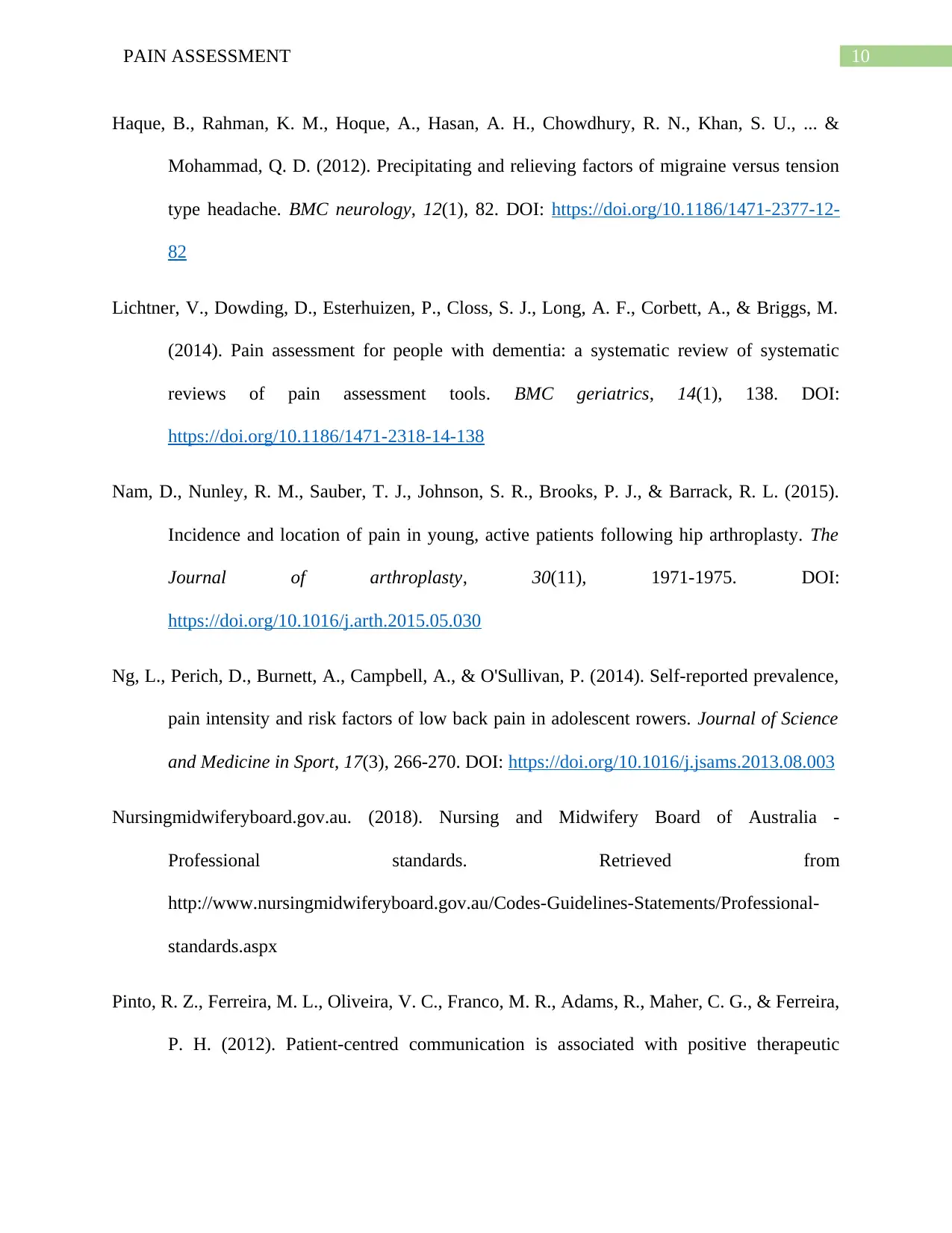
10PAIN ASSESSMENT
Haque, B., Rahman, K. M., Hoque, A., Hasan, A. H., Chowdhury, R. N., Khan, S. U., ... &
Mohammad, Q. D. (2012). Precipitating and relieving factors of migraine versus tension
type headache. BMC neurology, 12(1), 82. DOI: https://doi.org/10.1186/1471-2377-12-
82
Lichtner, V., Dowding, D., Esterhuizen, P., Closs, S. J., Long, A. F., Corbett, A., & Briggs, M.
(2014). Pain assessment for people with dementia: a systematic review of systematic
reviews of pain assessment tools. BMC geriatrics, 14(1), 138. DOI:
https://doi.org/10.1186/1471-2318-14-138
Nam, D., Nunley, R. M., Sauber, T. J., Johnson, S. R., Brooks, P. J., & Barrack, R. L. (2015).
Incidence and location of pain in young, active patients following hip arthroplasty. The
Journal of arthroplasty, 30(11), 1971-1975. DOI:
https://doi.org/10.1016/j.arth.2015.05.030
Ng, L., Perich, D., Burnett, A., Campbell, A., & O'Sullivan, P. (2014). Self-reported prevalence,
pain intensity and risk factors of low back pain in adolescent rowers. Journal of Science
and Medicine in Sport, 17(3), 266-270. DOI: https://doi.org/10.1016/j.jsams.2013.08.003
Nursingmidwiferyboard.gov.au. (2018). Nursing and Midwifery Board of Australia -
Professional standards. Retrieved from
http://www.nursingmidwiferyboard.gov.au/Codes-Guidelines-Statements/Professional-
standards.aspx
Pinto, R. Z., Ferreira, M. L., Oliveira, V. C., Franco, M. R., Adams, R., Maher, C. G., & Ferreira,
P. H. (2012). Patient-centred communication is associated with positive therapeutic
Haque, B., Rahman, K. M., Hoque, A., Hasan, A. H., Chowdhury, R. N., Khan, S. U., ... &
Mohammad, Q. D. (2012). Precipitating and relieving factors of migraine versus tension
type headache. BMC neurology, 12(1), 82. DOI: https://doi.org/10.1186/1471-2377-12-
82
Lichtner, V., Dowding, D., Esterhuizen, P., Closs, S. J., Long, A. F., Corbett, A., & Briggs, M.
(2014). Pain assessment for people with dementia: a systematic review of systematic
reviews of pain assessment tools. BMC geriatrics, 14(1), 138. DOI:
https://doi.org/10.1186/1471-2318-14-138
Nam, D., Nunley, R. M., Sauber, T. J., Johnson, S. R., Brooks, P. J., & Barrack, R. L. (2015).
Incidence and location of pain in young, active patients following hip arthroplasty. The
Journal of arthroplasty, 30(11), 1971-1975. DOI:
https://doi.org/10.1016/j.arth.2015.05.030
Ng, L., Perich, D., Burnett, A., Campbell, A., & O'Sullivan, P. (2014). Self-reported prevalence,
pain intensity and risk factors of low back pain in adolescent rowers. Journal of Science
and Medicine in Sport, 17(3), 266-270. DOI: https://doi.org/10.1016/j.jsams.2013.08.003
Nursingmidwiferyboard.gov.au. (2018). Nursing and Midwifery Board of Australia -
Professional standards. Retrieved from
http://www.nursingmidwiferyboard.gov.au/Codes-Guidelines-Statements/Professional-
standards.aspx
Pinto, R. Z., Ferreira, M. L., Oliveira, V. C., Franco, M. R., Adams, R., Maher, C. G., & Ferreira,
P. H. (2012). Patient-centred communication is associated with positive therapeutic
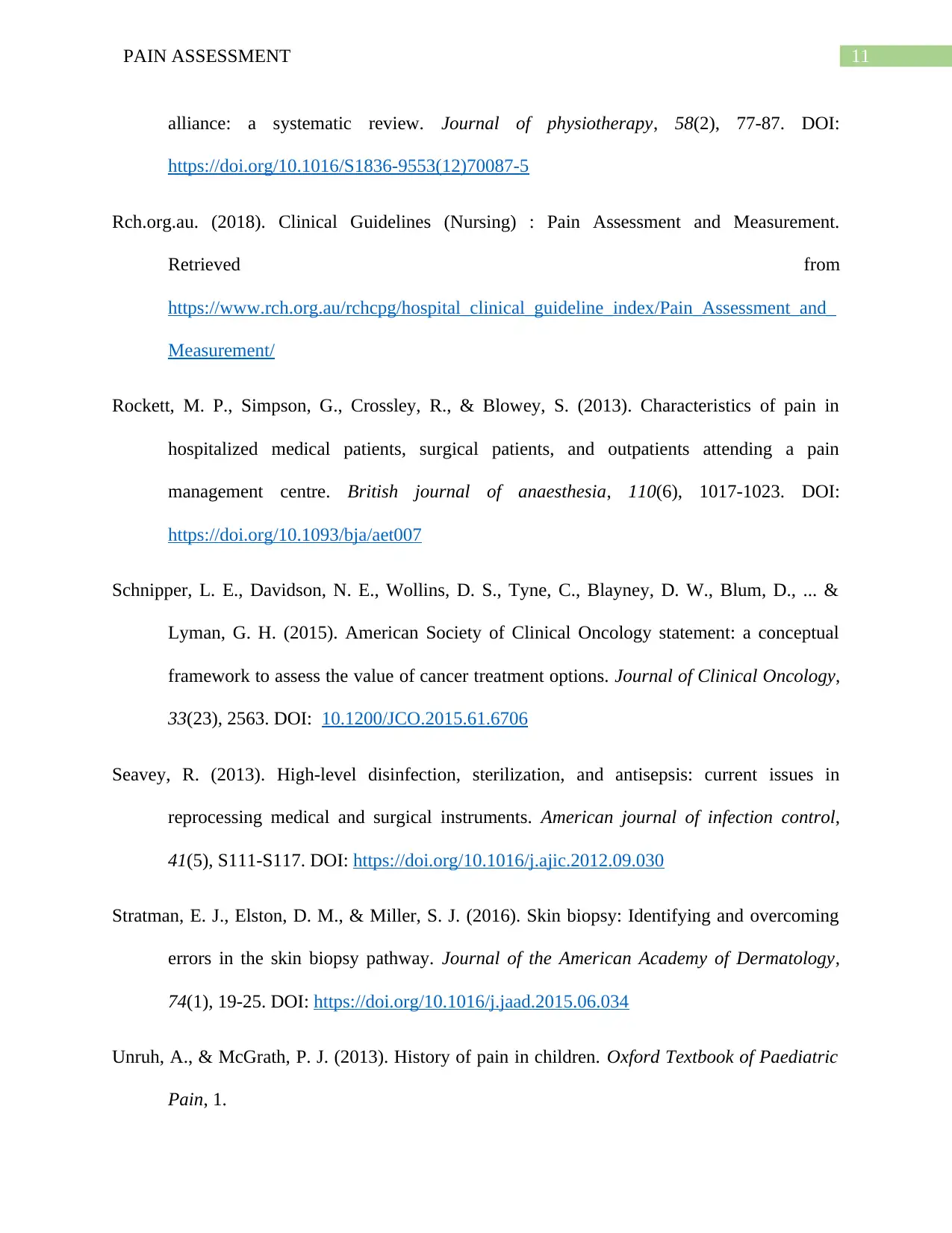
11PAIN ASSESSMENT
alliance: a systematic review. Journal of physiotherapy, 58(2), 77-87. DOI:
https://doi.org/10.1016/S1836-9553(12)70087-5
Rch.org.au. (2018). Clinical Guidelines (Nursing) : Pain Assessment and Measurement.
Retrieved from
https://www.rch.org.au/rchcpg/hospital_clinical_guideline_index/Pain_Assessment_and_
Measurement/
Rockett, M. P., Simpson, G., Crossley, R., & Blowey, S. (2013). Characteristics of pain in
hospitalized medical patients, surgical patients, and outpatients attending a pain
management centre. British journal of anaesthesia, 110(6), 1017-1023. DOI:
https://doi.org/10.1093/bja/aet007
Schnipper, L. E., Davidson, N. E., Wollins, D. S., Tyne, C., Blayney, D. W., Blum, D., ... &
Lyman, G. H. (2015). American Society of Clinical Oncology statement: a conceptual
framework to assess the value of cancer treatment options. Journal of Clinical Oncology,
33(23), 2563. DOI: 10.1200/JCO.2015.61.6706
Seavey, R. (2013). High-level disinfection, sterilization, and antisepsis: current issues in
reprocessing medical and surgical instruments. American journal of infection control,
41(5), S111-S117. DOI: https://doi.org/10.1016/j.ajic.2012.09.030
Stratman, E. J., Elston, D. M., & Miller, S. J. (2016). Skin biopsy: Identifying and overcoming
errors in the skin biopsy pathway. Journal of the American Academy of Dermatology,
74(1), 19-25. DOI: https://doi.org/10.1016/j.jaad.2015.06.034
Unruh, A., & McGrath, P. J. (2013). History of pain in children. Oxford Textbook of Paediatric
Pain, 1.
alliance: a systematic review. Journal of physiotherapy, 58(2), 77-87. DOI:
https://doi.org/10.1016/S1836-9553(12)70087-5
Rch.org.au. (2018). Clinical Guidelines (Nursing) : Pain Assessment and Measurement.
Retrieved from
https://www.rch.org.au/rchcpg/hospital_clinical_guideline_index/Pain_Assessment_and_
Measurement/
Rockett, M. P., Simpson, G., Crossley, R., & Blowey, S. (2013). Characteristics of pain in
hospitalized medical patients, surgical patients, and outpatients attending a pain
management centre. British journal of anaesthesia, 110(6), 1017-1023. DOI:
https://doi.org/10.1093/bja/aet007
Schnipper, L. E., Davidson, N. E., Wollins, D. S., Tyne, C., Blayney, D. W., Blum, D., ... &
Lyman, G. H. (2015). American Society of Clinical Oncology statement: a conceptual
framework to assess the value of cancer treatment options. Journal of Clinical Oncology,
33(23), 2563. DOI: 10.1200/JCO.2015.61.6706
Seavey, R. (2013). High-level disinfection, sterilization, and antisepsis: current issues in
reprocessing medical and surgical instruments. American journal of infection control,
41(5), S111-S117. DOI: https://doi.org/10.1016/j.ajic.2012.09.030
Stratman, E. J., Elston, D. M., & Miller, S. J. (2016). Skin biopsy: Identifying and overcoming
errors in the skin biopsy pathway. Journal of the American Academy of Dermatology,
74(1), 19-25. DOI: https://doi.org/10.1016/j.jaad.2015.06.034
Unruh, A., & McGrath, P. J. (2013). History of pain in children. Oxford Textbook of Paediatric
Pain, 1.
⊘ This is a preview!⊘
Do you want full access?
Subscribe today to unlock all pages.

Trusted by 1+ million students worldwide
1 out of 13
Related Documents
Your All-in-One AI-Powered Toolkit for Academic Success.
+13062052269
info@desklib.com
Available 24*7 on WhatsApp / Email
![[object Object]](/_next/static/media/star-bottom.7253800d.svg)
Unlock your academic potential
Copyright © 2020–2025 A2Z Services. All Rights Reserved. Developed and managed by ZUCOL.





